Research on Delineation and Assessment Methods for Cultivated Land Concentration and Contiguity in Southeastern China
Abstract
1. Introduction
2. Materials and Methods
2.1. Study Area
2.2. Data Sources
2.3. Methods
2.3.1. Related Definitions and Regulations
2.3.2. Data Processing
- First digit: Indicates direct adjacency between patches (1 denotes direct connection, 0 signifies no direct contact);
- Second digit: Represents connectivity through irrigation ditches (as connecting elements);
- Third digit: Signifies linkage via rural roads (as connecting elements);
- Fourth digit: Denotes connection through paved road (as connecting elements);
- Fifth digit: Indicates connectivity via river systems (as connecting elements);
- Sixth digit: Indicates composite element connectivity between patches.
2.3.3. Spatial Relationship Evaluation
2.3.4. Integrated Contiguity Assessment
- (a)
- Construct pairwise comparison matrix
- (b)
- Perform consistency verification
- (a)
- First, an initial evaluation matrix is constructed using objects and indicators:
- (b)
- Second, based on the specific indicator type, the evaluation matrix undergoes positive or negative directional standardization.
- (c)
- Then, the information entropy for each indicator is calculated:
- (d)
- Finally, the entropy weight for each indicator is determined:
3. Results
3.1. Spatiotemporal Distribution Characteristics of Indices
3.1.1. Patch Connectivity Index (PCI)
3.1.2. Patch Area Index (PAI)
3.1.3. Patch Shape Index (PSI)
3.2. Classification of Cultivated Land Concentration and Contiguity Grades
4. Discussion
4.1. Delineation Methodology for Cultivated Land Concentration and Contiguity
4.2. Analysis of Cultivated Land Concentration and Contiguity Evaluation Results
4.3. Prospects
5. Conclusions
Author Contributions
Funding
Data Availability Statement
Acknowledgments
Conflicts of Interest
References
- Tian, R.; Yang, Z.; Shao, Q. China’s Arable Land Investment in the “Belt and Road” Region: An Empirical Study of Overseas Arable Land Resources. Sustainability 2019, 12, 97. [Google Scholar] [CrossRef]
- Zhao, T.; Zhang, X.; Liu, W.; Wang, J.; Li, Z.; Liu, L. Increase in Global per Capita Cropland Imbalance across Countries from 1985 to 2022: A Threat to Achieving Sustainable Development Goals. Geogr. Sustain. 2025, 6, 100239. [Google Scholar] [CrossRef]
- Du, Z.; Yu, L.; Chen, X.; Li, X.; Peng, D.; Zheng, S.; Hao, P.; Yang, J.; Guo, H.; Gong, P. An Operational Assessment Framework for Near Real-Time Cropland Dynamics: Toward Sustainable Cropland Use in Mid-Spine Belt of Beautiful China. J. Remote Sens. 2023, 3, 0065. [Google Scholar] [CrossRef]
- Lee, C.-C.; Li, J.; Zeng, M. Construction of China’s Food Security Evaluation Index System and Spatiotemporal Evolution. Environ. Sci. Pollut. Res. 2024, 31, 25014–25032. [Google Scholar] [CrossRef]
- Yang, D.; Liu, Z.; Zhang, P.; Chen, Z.; Chang, Y.; Wang, Q.; Zhang, X.; Lu, R.; Li, M.; Xing, G.; et al. Understanding Relationships between Cultivated Land Pressure and Economic Development Level across Spatiotemporal Characteristics: Implications for Supporting Land-Use Management Decisions. Int. J. Environ. Res. Public Health 2022, 19, 16362. [Google Scholar] [CrossRef]
- Zhao, S.; Yin, M. Change of Urban and Rural Construction Land and Driving Factors of Arable Land Occupation. PLoS ONE 2023, 18, e0286248. [Google Scholar] [CrossRef] [PubMed]
- Liu, Y. Reflections on China’s Food Security and Land Use Policy under Rapid Urbanization. Land Use Policy 2021, 109, 105699. [Google Scholar] [CrossRef]
- Yang, S.; Li, D.; Liao, H.; Zhu, L.; Zhou, M.; Cai, Z. Analysis of the Balance between Supply and Demand of Arable Land in China Based on Food Security. Sustainability 2023, 15, 5706. [Google Scholar] [CrossRef]
- Hua, Y.; Ong, P.Y.; Tran, C.N.; Lee, C.T.; Nagasaka, K. A Novel Stereoscopic Mode of Planting and Breeding Shed. Plant Sci. Today 2024, 12. [Google Scholar] [CrossRef]
- Chen, M.; Liu, T.; Zhou, B.; Xu, X. The Effectiveness of Cultivated Land Protection and Strategies in China. In Proceedings of the 2013 International Academic Workshop on Social Science (IAW-SC-13), Changsha, China, 18–20 October 2013; Atlantis Press: Hunan, China, 2013. [Google Scholar]
- Guan, X.; Wang, X.; Zhang, J.; Dai, Z. Regulation and Optimization of Cultivated Land in Different Ecological Function Areas under the Guidance of Food Security Goals-a Case Study of Mengjin County, Henan Province, China. Front. Environ. Sci. 2023, 11, 1115640. [Google Scholar] [CrossRef]
- Zheng, L.; Wang, J.; Zeng, Y.; Gu, T.; Chen, W. Impacts of Construction Land Expansion on Cultivated Land Fragmentation in China, 2000–2020. Environ. Monit. Assess. 2025, 197, 300. [Google Scholar] [CrossRef]
- Xiao, Y.; Chen, J.; Yin, P. Institutionalization of Ecological Civilization Construction in China: Measurements and Influencing Factors. Sustainability 2025, 17, 1719. [Google Scholar] [CrossRef]
- Li, Y.; Zhang, F. Problems and Solutions of High Standard Farmland Construction. Front. Sustain. Dev. 2024, 4, 50–54. [Google Scholar] [CrossRef]
- Lin, L.; Ye, Z.; Gan, M.; Shahtahmassebi, A.; Weston, M.; Deng, J.; Lu, S.; Wang, K. Quality Perspective on the Dynamic Balance of Cultivated Land in Wenzhou, China. Sustainability 2017, 9, 95. [Google Scholar] [CrossRef]
- Wang, W.; Chen, Y.; Liu, K.; Dang, Y.; Li, G.; Wen, L.; Cao, Y. Optimization and Classification Control of Permanent Basic Farmland Based on Quality Classification. Front. Environ. Sci. 2024, 12, 1331534. [Google Scholar] [CrossRef]
- Jiang, G.; Ma, W.; Li, Y.; Zhou, D.; Zhou, T. Mapping Abandoned Cultivated Land in China: Implications for Grain Yield Improvement. Appl. Sci. 2024, 15, 165. [Google Scholar] [CrossRef]
- National Bureau of Statistics of China. China Statistical Yearbook 2024; China Statistics Press: Beijing, China, 2024; pp. 379–381. [Google Scholar]
- Liu, S.; Wang, L.; Zhang, J. The Dataset of Main Grain Land Changes in China over 1985–2020. Sci. Data 2024, 11, 1430. [Google Scholar] [CrossRef] [PubMed]
- Li, J.; Feng, Y.; Gu, L. Telecoupling Effects among Provinces of Cultivated Land Grain Production in the Last 30 Years: Evidence from China. Agriculture 2024, 14, 1121. [Google Scholar] [CrossRef]
- Chen, W.; Wang, N. Study on the Construction of Evaluation System of Cultivated Land Intensive Use in Different Spatial Scales. Front. Humanit. Soc. Sci. 2024, 4, 312–316. [Google Scholar] [CrossRef]
- Rahman, T.U.; Shah, S.; Hassan, S.; Fahad, S. Food Security Challenges and Adaptation Strategies in China amidst Global Climate Change. J. Umm Al-Qura Univ. Appll. Sci. 2025, 1–14. [Google Scholar] [CrossRef]
- Zhou, S.; Zhu, A.; Qiu, W.; Liu, F.; Dai, J. GIS based connectivity analysis and its application in prime farmland protection planning. Trans. Chin. Soc. Agric. Eng. 2008, 24, 72–77+313. [Google Scholar]
- Ma, S.; Zhang, S. Map Vector Tile Construction for Arable Land Spatial Connectivity Analysis Based on the Hadoop Cloud Platform. Front. Earth Sci. 2023, 11, 1234732. [Google Scholar] [CrossRef]
- Guo, Z.; Yang, Y. GIS-Based Farmland Connectivity Analysis Methods Research and System Implementation. Geogr. Geo-Inf. Sci. 2010, 63–66+117. [Google Scholar]
- Tian, H.; Zhang, X.; Bi, R.; Yang, J.; Li, G.; Zhang, J. Prime Farmland Demarcation Based on Arable Land Quality and Concentricity in Non-Uniform Grid Environment. Trans. Chin. Soc. Agric. Eng. 2020, 36, 254–262+321. [Google Scholar] [CrossRef]
- Li, Z.; Bagan, H.; Yamagata, Y. Analysis of Spatiotemporal Land Cover Changes in Inner Mongolia Using Self-Organizing Map Neural Network and Grid Cells Method. Sci. Total Environ. 2018, 636, 1180–1191. [Google Scholar] [CrossRef] [PubMed]
- Fan, Y. Distribution Extraction and Influencing Factors of Farmland Concentrated Contiguous Management—A Case Study of Yunzhou District, Datong City of China. Master’s Thesis, Shanxi Agricultural University, Taigu, China, 2023. [Google Scholar]
- Bhermana, A.; Nursafingi, A.; Purwoko, S.; Haryanto, B.; Nugroho, W.A.; Agustini, S.; Nuraini, L.; Wardi; Heryanto, R.B.; Prasetyo, C. Agricultural Land Use Planning on Sustained Basis Using Landform and Land Evaluation Approach with Geospatial Analysis (A Case Study in East Barito District, Central Kalimantan Province). IOP Conf. Ser. Earth Environ. Sci. 2023, 1264, 012039. [Google Scholar] [CrossRef]
- Churko, G.; Walter, T.; Szerencsits, E.; Gramlich, A. Improving Wetland Connectivity through the Promotion of Wet Arable Land. Wetl. Ecol. Manag. 2020, 28, 667–680. [Google Scholar] [CrossRef]
- Zhang, X.; Liao, Q.; Zhao, H.; Li, P. Vector Maps and Spatial Autocorrelation of Carbon Emissions at Land Patch Level Based on Multi-Source Data. Front. Public Health 2022, 10, 1006337. [Google Scholar] [CrossRef] [PubMed]
- Si, R.; Yao, Y.; Zhang, X.; Lu, Q.; Aziz, N. Exploring the Role of Contiguous Farmland Cultivation and Adoption of No-Tillage Technology in Improving Transferees’ Income Structure: Evidence from China. Land 2022, 11, 570. [Google Scholar] [CrossRef]
- Yang, H.; Li, J.; Sieber, S.; Long, K. Does Digital Village Construction Affect the Sustainable Intensification of Cultivated Land Use? Evidence from Rural China. Agriculture 2025, 15, 978. [Google Scholar] [CrossRef]
- Deng, Y.; Mao, Z.; Huang, J.; Yan, F.; Han, S.; Li, A. Spatial Patterns of Natural Protected Areas and Construction of Protected Area Groups in Guangdong Province. Int. J. Environ. Res. Public Health 2022, 19, 14874. [Google Scholar] [CrossRef]
- Fang, W.; Yang, Z.; Liu, Z.; Hatab, A.A. Green Recovery of Cropland Carrying Capacity in Developed Regions: Empirical Evidence from Guangdong, China. Econ. Change Restruct. 2023, 56, 2405–2436. [Google Scholar] [CrossRef]
- Su, M.; Sun, K.; Deng, B.; Cheng, N.; Cao, Y. Quantification and Driving Factors of Cultivated Land Fragmentation in Rapidly Urbanizing Area: A Case Study in Guangdong Province. Remote Sens. 2024, 16, 2633. [Google Scholar] [CrossRef]
- Xiao, Y.; Zhao, J.; Zhang, Y.; Wang, S. Grain Self-Sufficiency in Guangdong, China: Current Trends and Future Perspectives. Foods 2025, 14, 1126. [Google Scholar] [CrossRef]
- Wang, D.; Yang, H.; Hu, Y.; Zhu, A.-X.; Mao, X. Analyzing Spatio-Temporal Characteristics of Cultivated Land Fragmentation and Their Influencing Factors in a Rapidly Developing Region: A Case Study in Guangdong Province, China. Land 2022, 11, 1750. [Google Scholar] [CrossRef]
- TD/T 1055-2019; Technical Regulation of the Third Nationwide Land Survey. Ministry of Natural Resources of the People’s Republic of China: Beijing, China, 2019.
- Huang, H.; Lan, Y. The Analysis and Application of Guangxi’s Concentrated Arable Land Based on ArcGIS on Boundary Line of Guangxi’s Arable Land (Research Paper III). J. Guangxi Teach. Educ. Univ. (Philos. Soc. Sci. Ed.) 2018, 39, 142–148. [Google Scholar] [CrossRef]
- Bunn, A.G.; Urban, D.L.; Keitt, T.H. Landscape Connectivity: A Conservation Application of Graph Theory. J. Environ. Manag. 2000, 59, 265–278. [Google Scholar] [CrossRef]
- Lu, X.; Wu, P.; Guo, X. Application of binary morphological closing operation for aggregation connectivity planning in high-quality arable land. J. Image Graph. 2016, 21, 199–206. [Google Scholar] [CrossRef]
- GB/T 30600-2022; Well-Facilitated Farmland Construction—General Rules. National Standardization Administration Standardization Administration of China, State Administration for Market Regulation: Beijing, China, 2022.
- TD/T 1076-2023; Technical Specification for Generalization of Land Survey Data. Ministry of Natural Resources of the People’s Republic of China: Beijing, China, 2023.
- JTG B01-2014; Technical Standard of Highway Engineering. Highway Administration, Ministry of Transport of the People’s Republic of China: Beijing China; CCCC FIRST CCCC First Highway Consultants Co., Ltd.: Xi’an, China, 2014.
- Penghui, J.; Dengshuai, C.; Manchun, L. Farmland Landscape Fragmentation Evolution and Its Driving Mechanism from Rural to Urban: A Case Study of Changzhou City. J. Rural Stud. 2021, 82, 1–18. [Google Scholar] [CrossRef]
- Wang, Z.; Wang, J.; Zhang, G.; Wang, Z. Evaluation of Agricultural Extension Service for Sustainable Agricultural Development Using a Hybrid Entropy and TOPSIS Method. Sustainability 2021, 13, 347. [Google Scholar] [CrossRef]
- Shi, Y.; Jin, X.; Liang, X.; Han, B.; Ying, S.; Wang, S.; Zhou, Y. Spatial-Temporal Characteristics and Strategies for the Classification and Optimization of Cultivated Land Agglomeration Connectivity in Jiangsu Province of China. Trans. Chin. Soc. Agric. Eng. 2024, 40, 250–260. [Google Scholar] [CrossRef]
- Shengwu, Z.; Juan, H. Impact of Interprovincial Pairing Assistance Policies on Sustainable Agricultural Development in Xinjiang of China. Sci. Rep. 2025, 15, 8372. [Google Scholar] [CrossRef]
- Zhu, J.; Li, G.; Zhang, J.; Liu, H. A Decision Model for High School Students’ Summer Job Choices: A Study Combining Hierarchical Analysis and Entropy Power Methods. Int. J. Educ. Humanit. 2024, 14, 23–28. [Google Scholar] [CrossRef]
- Chen, H.; Zhu, D.; Yun, W.; Yang, L.; Tang, H.; Tang, C. Analysis on Cultivated Land Fragmentation and Spatial Agglomeration Pattern in Jiaxing City. Trans. Chin. Soc. Agric. Eng. 2012, 28, 235–242. [Google Scholar]
- Wang, X.; Jiang, G.; Zhang, R.; Zhao, T.; Qu, Y. Zoning Approach of Suitable Areas for High Quality Capital Farmland Construction. Trans. Chin. Soc. Agric. Eng. 2013, 29, 241–250. [Google Scholar]
- Ren, X. Evaluation of Cabin Energy Consumption Based on Combination Weighting and Grey Fuzzy Comprehensive Model. EURASIP J. Adv. Signal Process. 2022, 2022, 36. [Google Scholar] [CrossRef]
- Cui, Z.; Tian, W.; Wang, X.; Chenyang, F.; Guo, Q.; Xu, H. Safety Integrity Level Analysis of Fluid Catalytic Cracking Fractionating System Based on Dynamic Simulation. J. Taiwan Inst. Chem. Eng. 2019, 104, 16–26. [Google Scholar] [CrossRef]
- Liu, Q.; Qiao, J.; Han, D.; Li, M.; Shi, L. Spatiotemporal Evolution of Cultivated Land Use Eco-Efficiency and Its Dynamic Relationship with Landscape Pattern Change from the Perspective of Carbon Effect: A Case Study of Henan, China. Agriculture 2023, 13, 1350. [Google Scholar] [CrossRef]
- Tang, F.; Li, Y.; Liu, X.; Huang, J.; Zhang, Y.; Xu, Q. Understanding the Relationships between Landscape Eco-Security and Multifunctionality in Cropland: Implications for Supporting Cropland Management Decisions. Int. J. Environ. Res. Public Health 2023, 20, 1938. [Google Scholar] [CrossRef]
- Wang, Y.; Cheng, L.; Zheng, Y. An Adjusted Landscape Ecological Security of Cultivated Land Evaluation Method Based on the Interaction between Cultivated Land and Surrounding Land Types. Land 2023, 12, 833. [Google Scholar] [CrossRef]
- Wu, Y.; Zhang, W. The Impact of Land Transfer on Sustainable Agricultural Development from the Perspective of Green Total Factor Productivity. Sustainability 2024, 16, 7076. [Google Scholar] [CrossRef]
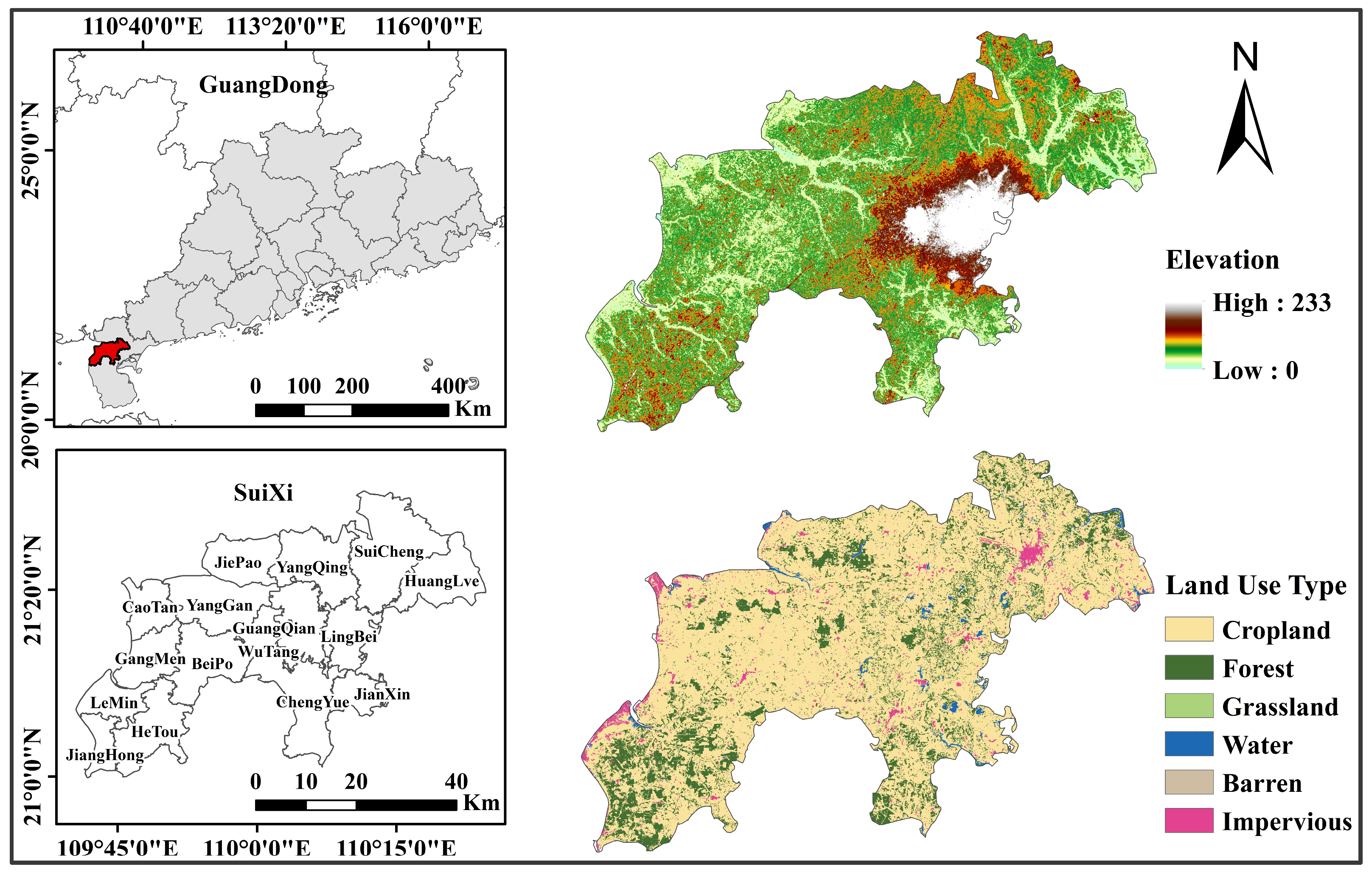
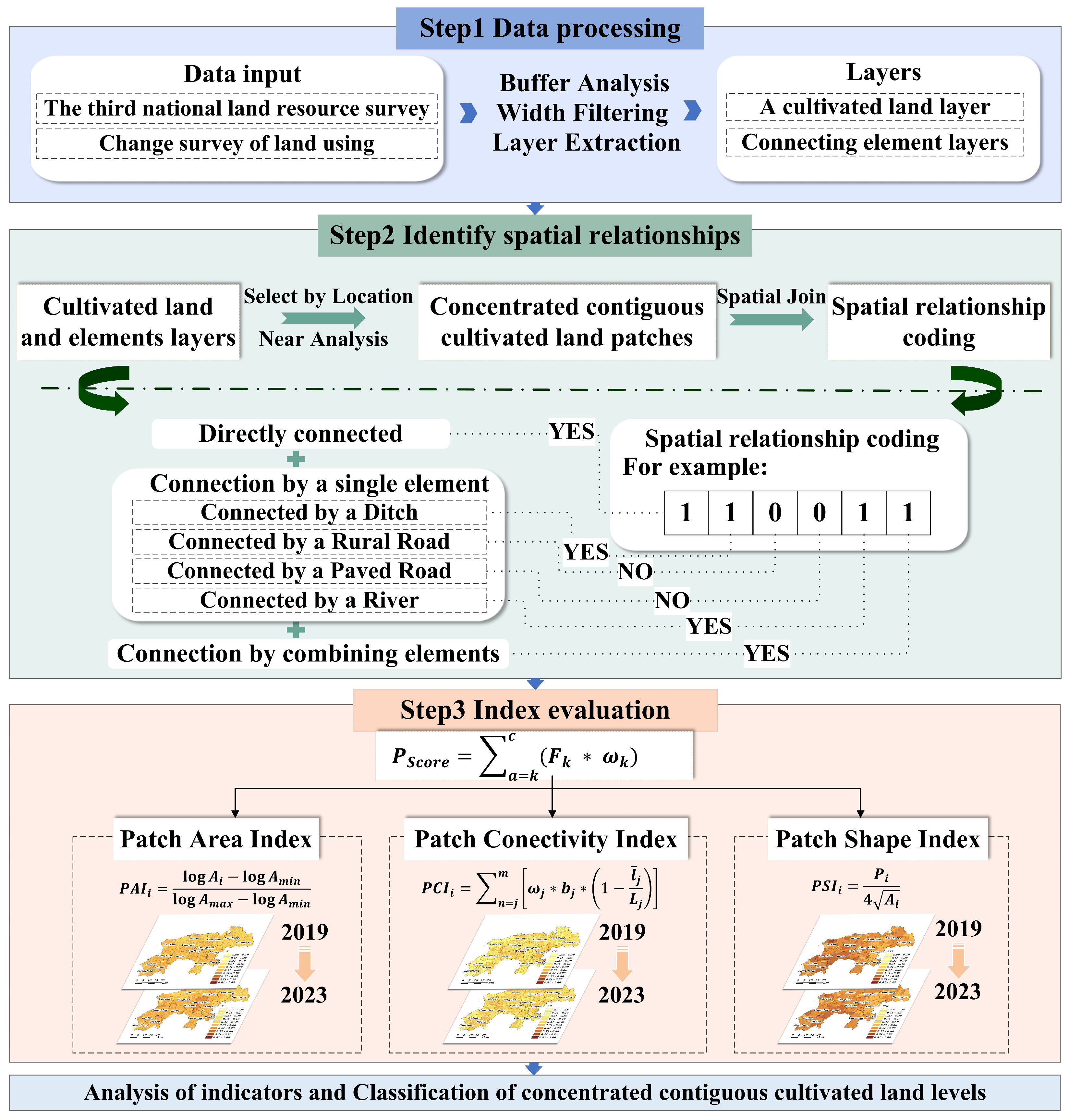

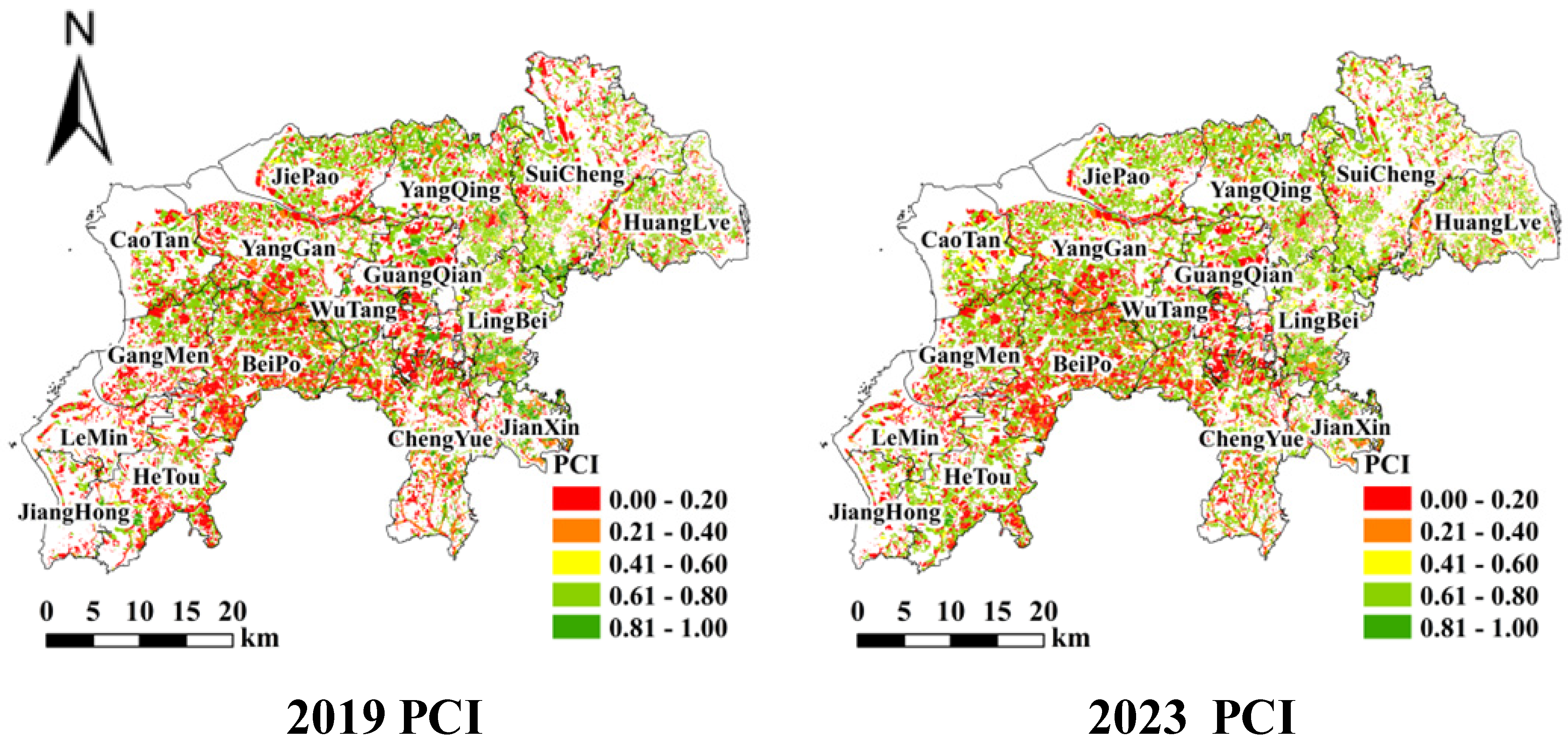
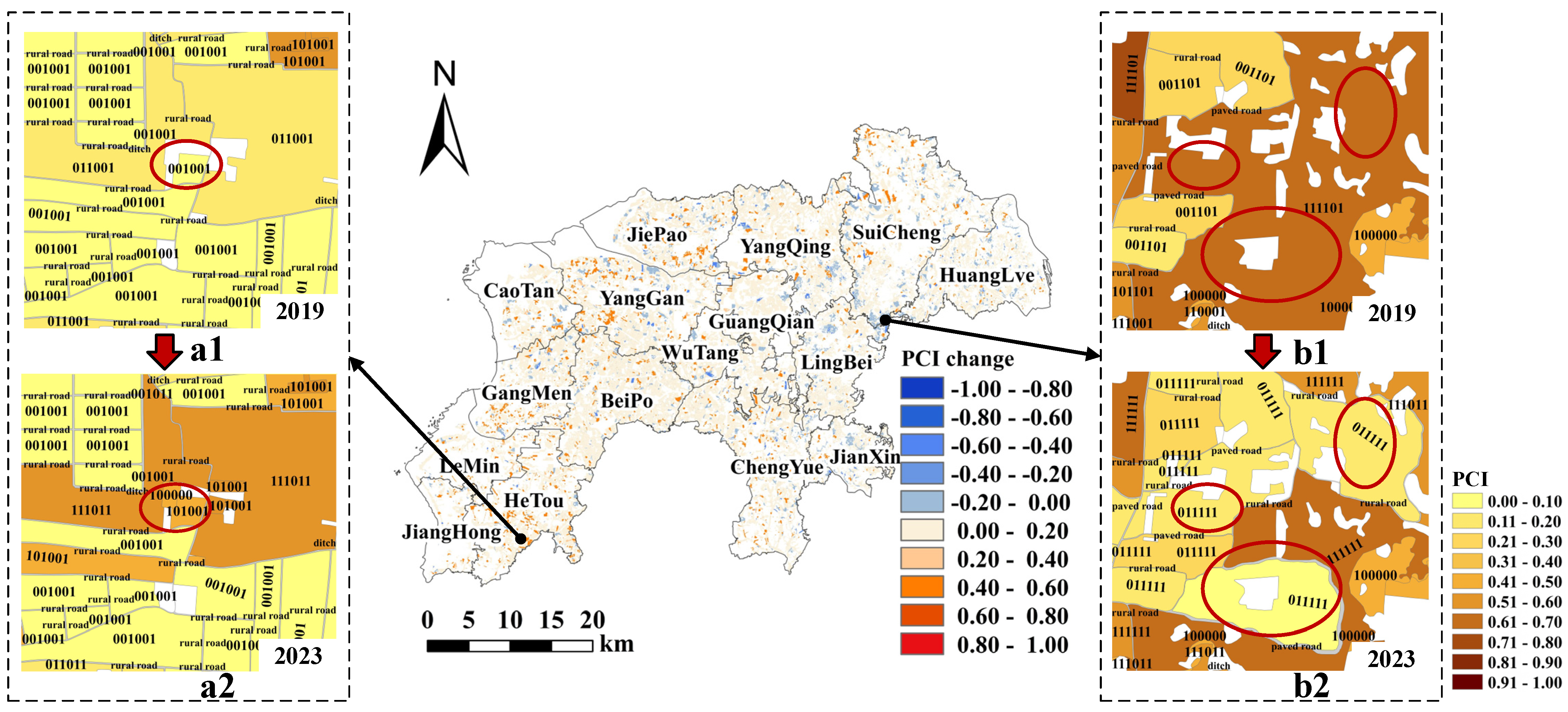
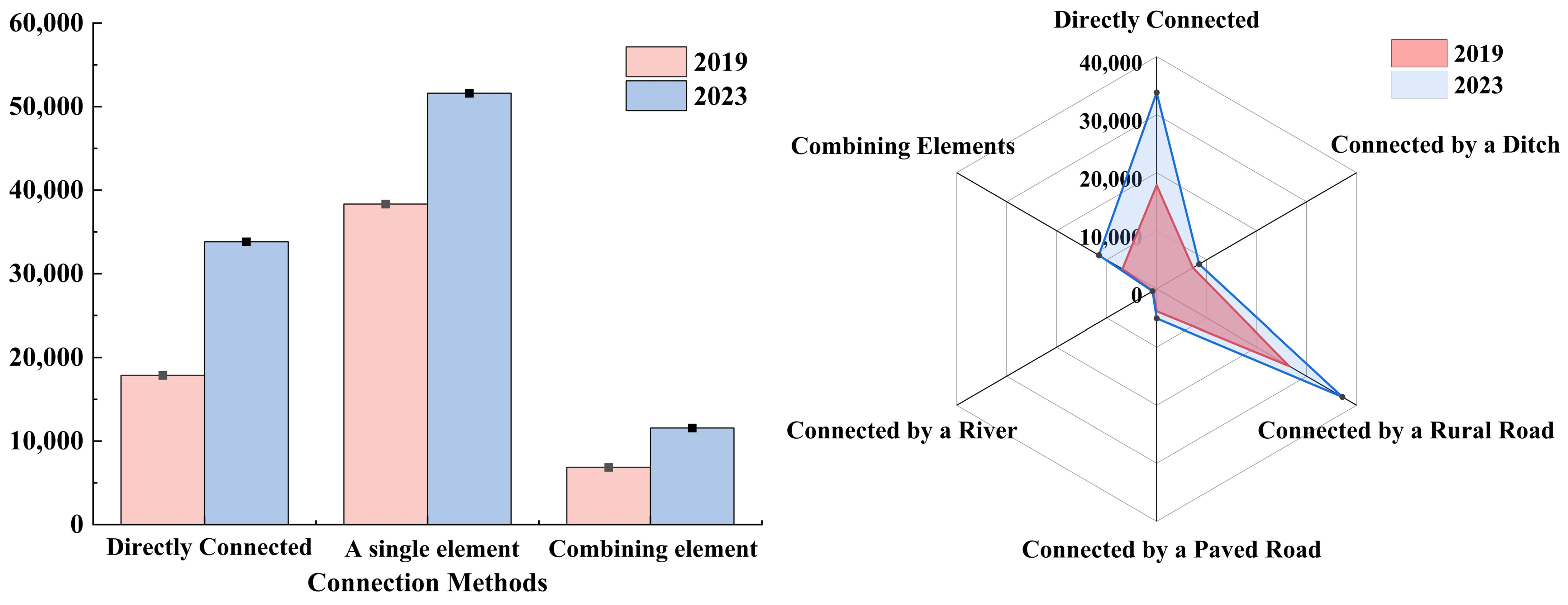
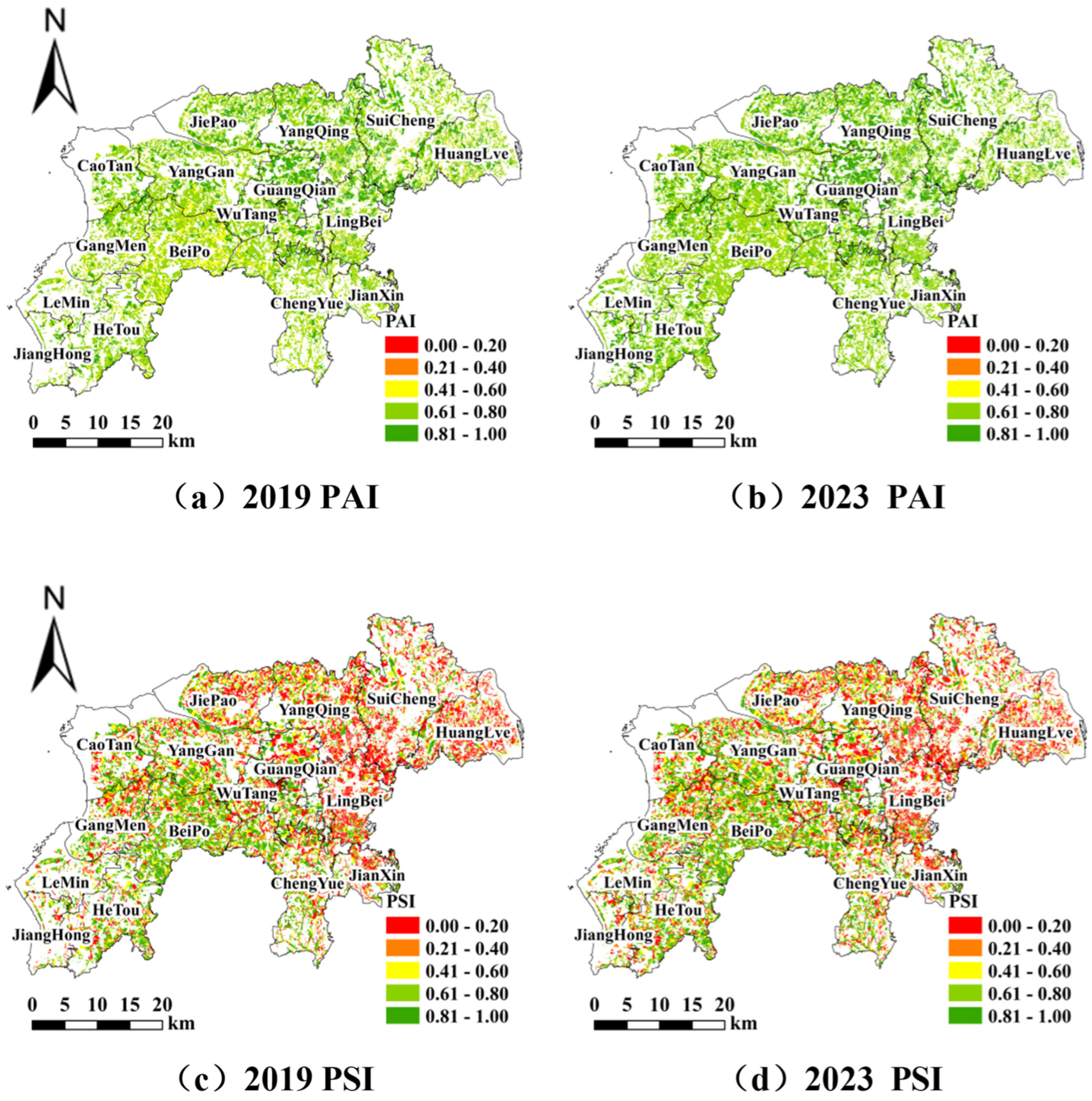
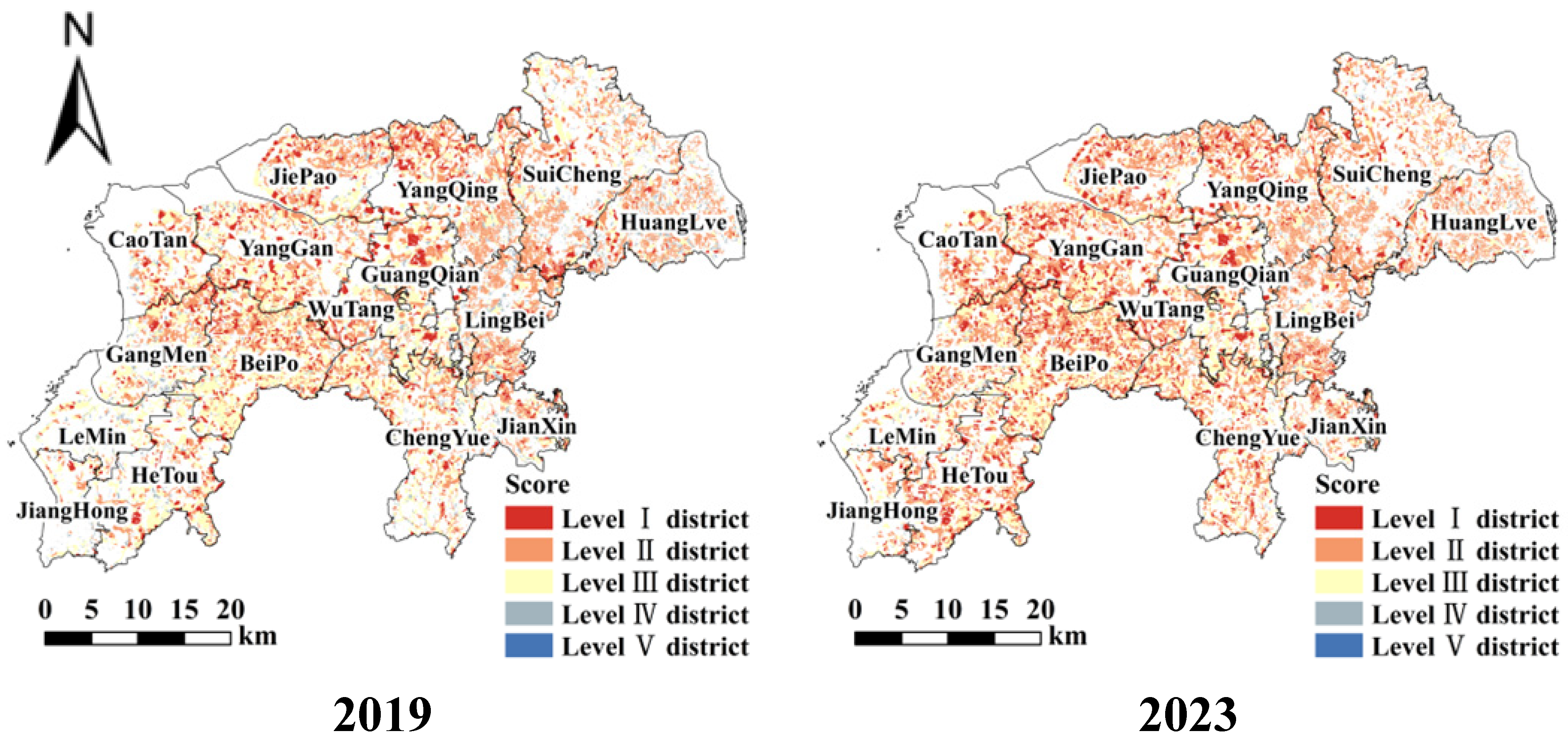
| Indicators | Formula | Indicator Meaning | Weight |
|---|---|---|---|
| Patch Connectivity Index | inter-patch spatial connectivity | 0.43 | |
| Patch Area Index | relative patch area magnitude | 0.39 | |
| Patch Shape Index | patch shape regularity | 0.18 |
| Scale Value | Interpretation |
|---|---|
| 1 | Equal importance |
| 3 | Moderate importance |
| 5 | Strong importance |
| 7 | Very strong importance |
| 9 | Extreme importance |
| 2, 4, 6, 8 | Intermediate values |
| Reciprocals | Inverse comparisons (1/3, 1/5……) |
| Year | Total Patches | Completely Disconnected Patches | Average Connectivity per Patch | Average Patch Area (km2) |
|---|---|---|---|---|
| 2019 | 38,356 | 3947 | 2 | 0.024 |
| 2023 | 49,909 | 4259 | 3 | 0.019 |
| 2023 | |||||||
|---|---|---|---|---|---|---|---|
| Grade I | Grade II | Grade III | Grade IV | Grade V | Sum | ||
| 2019 | Grade I | 1.35 | 2.31 | 0.13 | 0.00 | — | 3.79 |
| Grade II | 0.27 | 235.39 | 34.80 | 5.00 | 0.45 | 275.92 | |
| Grade III | 0.08 | 25.04 | 375.09 | 6.72 | 0.17 | 407.09 | |
| Grade IV | 0.01 | 35.86 | 45.91 | 119.88 | 0.67 | 202.34 | |
| Grade V | — | 0.10 | 2.29 | 5.27 | 5.25 | 12.91 | |
| Sum | 1.71 | 298.71 | 458.22 | 136.87 | 6.54 | 902.05 | |
Disclaimer/Publisher’s Note: The statements, opinions and data contained in all publications are solely those of the individual author(s) and contributor(s) and not of MDPI and/or the editor(s). MDPI and/or the editor(s) disclaim responsibility for any injury to people or property resulting from any ideas, methods, instructions or products referred to in the content. |
© 2025 by the authors. Licensee MDPI, Basel, Switzerland. This article is an open access article distributed under the terms and conditions of the Creative Commons Attribution (CC BY) license (https://creativecommons.org/licenses/by/4.0/).
Share and Cite
Wang, L.; Zhao, R.; Dong, C.; He, C.; Kang, X.; Zhang, L.; Wei, D.; Zhou, J.; He, L.; Liu, X.; et al. Research on Delineation and Assessment Methods for Cultivated Land Concentration and Contiguity in Southeastern China. Agriculture 2025, 15, 1803. https://doi.org/10.3390/agriculture15171803
Wang L, Zhao R, Dong C, He C, Kang X, Zhang L, Wei D, Zhou J, He L, Liu X, et al. Research on Delineation and Assessment Methods for Cultivated Land Concentration and Contiguity in Southeastern China. Agriculture. 2025; 15(17):1803. https://doi.org/10.3390/agriculture15171803
Chicago/Turabian StyleWang, Lei, Rong Zhao, Chun Dong, Chaoying He, Xiaochen Kang, Lina Zhang, Dong Wei, Junsong Zhou, Lihua He, Xiaoding Liu, and et al. 2025. "Research on Delineation and Assessment Methods for Cultivated Land Concentration and Contiguity in Southeastern China" Agriculture 15, no. 17: 1803. https://doi.org/10.3390/agriculture15171803
APA StyleWang, L., Zhao, R., Dong, C., He, C., Kang, X., Zhang, L., Wei, D., Zhou, J., He, L., Liu, X., & Wang, Y. (2025). Research on Delineation and Assessment Methods for Cultivated Land Concentration and Contiguity in Southeastern China. Agriculture, 15(17), 1803. https://doi.org/10.3390/agriculture15171803






